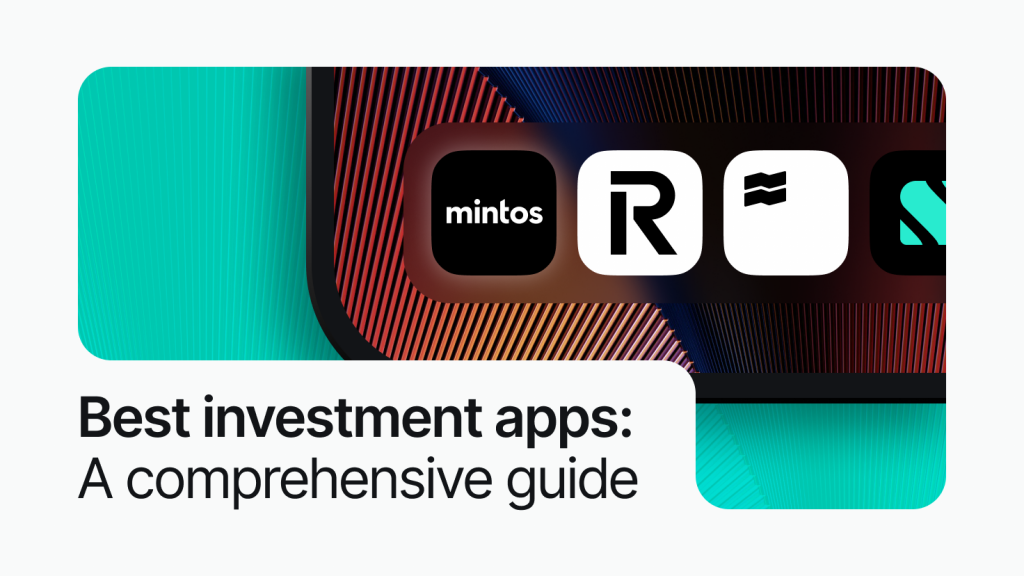Today’s investment apps have revolutionized the way people build and manage their portfolios, offering an accessible entry into the world of finance. With just a few taps, investors of all experience levels can buy stocks, track their portfolios, or even automate their investment strategies, usually with low fees. These apps provide a convenient way to explore new asset classes, set financial goals, and grow wealth over time.
In this article, we’ll review some of the top investment apps for 2025, comparing their unique features, fees, and investor profiles. Whether you’re just starting out or looking for advanced tools, this guide will help you select an app that aligns with your financial goals.
If you’re new to investing, start by reading up on the essentials with our guides on Investment Basics and Investing for Beginners. Now, let’s explore the world of investment apps and discover the one that best fits your needs.
What to look for in an investment app
Choosing the right investment app will allow you to build a portfolio that aligns with your needs. While many apps offer a similar core function, giving users access to a range of investment options, their features, fees, and overall approach can vary widely.
1. Ease of use
For both beginners and experienced investors, a user-friendly interface makes a world of difference. The best investment apps for beginners prioritize simplicity, offering easy navigation, straightforward tools, and an intuitive layout to make investing accessible to all.
2. Fees and costs
Investment fees can add up, especially for frequent traders or those with smaller portfolios. Look for low-fee investment apps that either eliminate fees entirely or offer transparent, reasonable rates. Some apps offer zero-commission trades, while others may charge a small fee per transaction. For long-term investors, a platform with low or no fees can make a big difference in overall returns.
3. Automation and robo-advisor options
Automation can make investing easier for people who want a more hands-off approach. Many investment apps for passive income include robo-advisor options, allowing you to set your preferences and let the app handle the rest.
If you’re focused on growing passive income, an app with auto-invest features is a good choice, as it can automatically reinvest returns according to your goals. For more on how automated investing works, check out this guide.
4. Educational tools
If you’re new to investing or want to expand your knowledge, look for investment apps with educational tools. Many top apps offer in-app tutorials, articles, and even courses.
Check out the Mintos blog for resources to help you make better decisions and improve your financial literacy over time.
5. Safety and security
Trustworthy investment apps prioritize user security, using encryption, two-factor authentication, and compliance with regulatory standards. Look for apps that provide clear information on how they safeguard your investments and adhere to financial security protocols.
Top investment apps in 2025
With so many investment apps available, finding the right one depends on factors like costs, investment variety, and the level of support for different types of investors. Here’s a look at some of the top investment apps of 2025 available in Europe. Whether you’re seeking low fees, educational tools, or advanced automation, there’s an app for you.
1. Mintos
Overview: Mintos is designed to cater to every kind of investor. With Mintos, you get a platform that’s both accessible and robust, combining advanced features with a straightforward user experience.
Unlike other apps that might focus solely on stocks and ETFs, Mintos provides a broad selection, including ETFs, loans, bonds, Smart Cash, and passive real estate investments. This wide range of options is ideal for investors looking for both diversity and high-yield investment apps.
Features: Mintos is an investment app with auto-invest features, making it a great choice for those seeking investment apps for passive income. Mintos investment app features make it easy to stay on top of your portfolio wherever you go and allows users to set up auto-invest strategies, which reinvest returns in line with their goals.
Fees: Mintos keeps costs low, offering a low-fee investment app experience without compromising on quality. This cost-effective model makes Mintos especially appealing for those wanting to keep more of their returns.
Best for: Whether you’re a small investor starting with just a few euros or a seasoned pro, Mintos has something to offer. Its flexibility, diverse asset range, and intuitive features make it a powerful, well-rounded option for anyone serious about growing their wealth.
2. Revolut
Overview: Revolut is a versatile mobile investing app that offers a range of financial services, from banking to investing, all within one platform. Known for its easy-to-use interface, Revolut is one of the investment apps with no minimum deposit, making it a convenient choice for beginners who want to start investing without a large upfront commitment.
Features: Revolut is an investment app with educational tools built into the app, helping newcomers understand the basics of investing. While it primarily focuses on stocks and ETFs, Revolut’s simple design and accessible learning resources provide a smooth starting point for users who are new to investing.
Fees: Revolut offers commission-free trading up to a monthly limit, with additional trades incurring fees, which may be a factor for more active investors.
Best for: This app is for those looking for a safe investment app to get started with small investments in a risk-managed environment. Revolut’s accessibility and ease of use make it a popular choice for beginners who wish to learn the fundamentals without complex barriers.
3. Trade Republic
Overview: Trade Republic appeals to those looking for a simple, low-cost way to start investing. With no minimum deposit, it’s accessible for small investors who want to explore the market with modest investments.
Features: This app emphasizes straightforward investing, with a clean, minimalist interface that suits beginners and casual investors. While it doesn’t offer advanced features like robo-advisors, its simplicity makes it a solid choice for those seeking investment apps with no minimum deposit and low barriers to entry.
Fees: Trade Republic has minimal fees, charging only a small transaction fee per trade, which keeps costs manageable for investors who want to maximize returns on a budget.
Best For: Trade Republic is ideal for small investors or those who want a no-fuss way to buy stocks and ETFs without worrying about high minimums or complex setups.
4. Scalable Capital
Overview: Known for its focus on long-term, diversified strategies, Scalable Capital offers users a way to invest passively while still retaining some control over asset choices.
Features: The app offers comprehensive planning resources, making it an option for investors who want a hands-off approach. This setup appeals to those weighing robo-advisors vs. investment apps and seeking a balance between automated management and personal choice.
Fees: Scalable Capital offers predictable fees with subscription packages, which can be more cost-effective for users investing larger amounts.
Best for: Scalable Capital suits those who prefer investment apps for passive income and want a more structured way to manage their portfolios.
5. Saxo Bank
- Overview: Saxo Bank is a well-established investment platform offering a range of financial products. With research tools and a suite of advanced trading features, Saxo Bank is tailored to experienced investors who are comfortable with higher fees in exchange for premium services.
Features: Saxo Bank’s platform offers in-depth research, advanced charting, and a wide range of global assets, making it a preferred choice for investors who want comprehensive market insights. While it’s not the best fit for beginners or budget-conscious users, Saxo Bank is popular among those who value advanced tools and market access.
Fees: Saxo Bank is among the higher-cost investment apps, with transaction fees, account fees, and minimum investment requirements that may be prohibitive for small investors.
- Best for: Saxo Bank is suited to advanced or high-net-worth investors who prioritize access to extensive research tools, diverse asset classes, and a professional-grade trading experience.
Pros and cons of using investment apps
As convenient as investment apps are, they come with both benefits and drawbacks. Understanding these can help you make informed choices about the best platform for your needs.
Pros
1. Flexibility in investment amounts
Investment apps often allow users to start with small amounts, making investing accessible regardless of budget. Some platforms are the best investment apps for small investors, enabling everyone from first-timers to seasoned pros to grow their portfolios without a large initial commitment.
2. Real-time portfolio management
One of the main advantages of mobile investing apps is the ability to track and adjust investments in real time. Notifications, market updates, and quick access allow users to stay informed and make timely adjustments from anywhere.
3. Enhanced learning opportunities
Many apps include resources that teach users how to invest, analyze markets, and manage portfolios, making investment apps with educational tools valuable for those looking to grow their financial knowledge as they invest.
4. Cost-effective passive income generation
Investment apps that include auto-invest make it easier to build passive income with minimal ongoing effort. This benefit appeals to those seeking investment apps for passive income that can handle the work of reinvesting and compounding returns automatically.
Cons
1. Limited personal guidance
While some apps offer robo-advisors, many lack the personalized support found with traditional advisors. This can be a drawback for those who prefer one-on-one financial advice, especially for complex financial situations.
2. Potential for overtrading
The convenience of mobile investing apps can sometimes encourage impulsive trading, which may be risky for inexperienced investors. Without careful planning, users might make decisions based on market fluctuations rather than a solid long-term strategy.
3. Restricted investment options
Although some apps like Mintos offer diverse asset choices, others may focus mainly on stocks and ETFs, limiting investors’ ability to fully diversify their portfolios. Those looking for options such as real estate or bonds may find fewer on certain platforms.
4. Security and privacy concerns
While most safe investment apps prioritize security with encryption and two-factor authentication, there’s still a risk of data breaches or other security issues. It’s essential to use reputable apps that prioritize user security.
Choosing the right investment app for your goals
Whether you’re interested in investment apps for passive income, beginner-friendly tools, or advanced features, Mintos offers a versatile platform that aligns with a variety of investment goals. With its unique range of assets, low fees, and choices of automated investing, Mintos stands out as a comprehensive choice for anyone looking to build and manage wealth efficiently. Mintos provides everything you need to grow wealth on your terms, making it a smart choice for investors at any level, from first-time users to experienced traders.
Want to know more?
Disclaimer:
This is a marketing communication and in no way should be viewed as investment research, investment advice, or recommendation to invest. The value of your investment can go up as well as down. Past performance of financial instruments does not guarantee future returns. Investing in financial instruments involves risk; before investing, consider your knowledge, experience, financial situation, and investment objectives.

